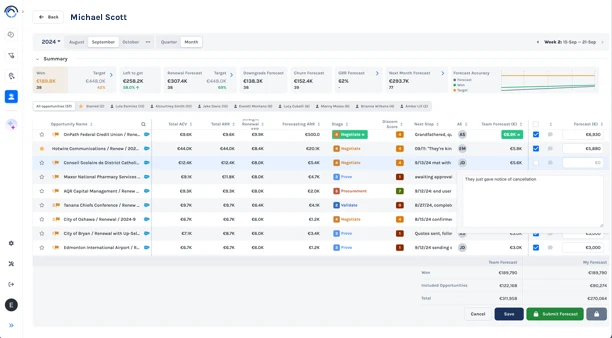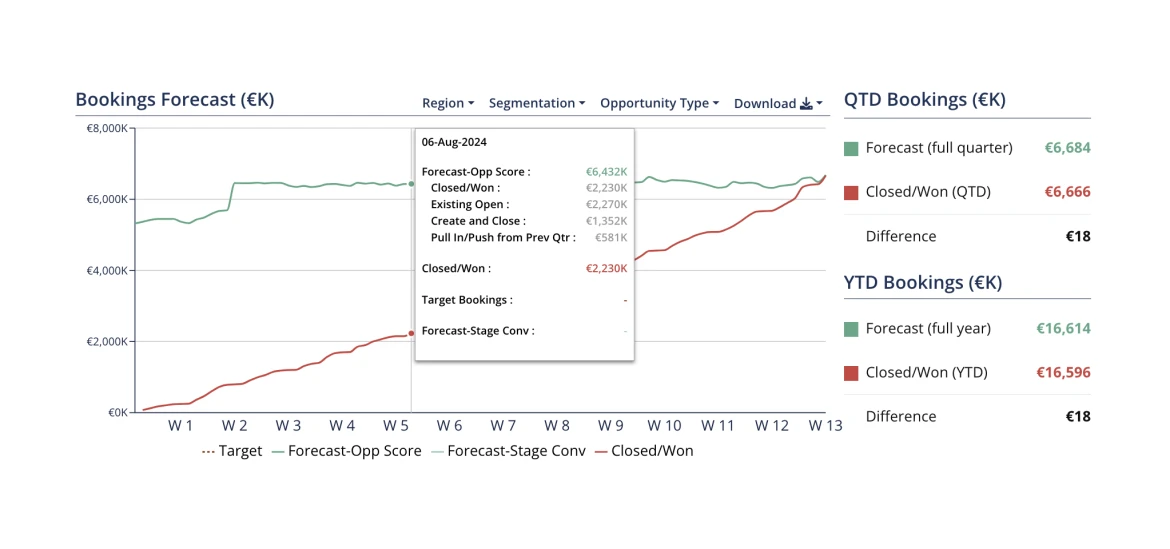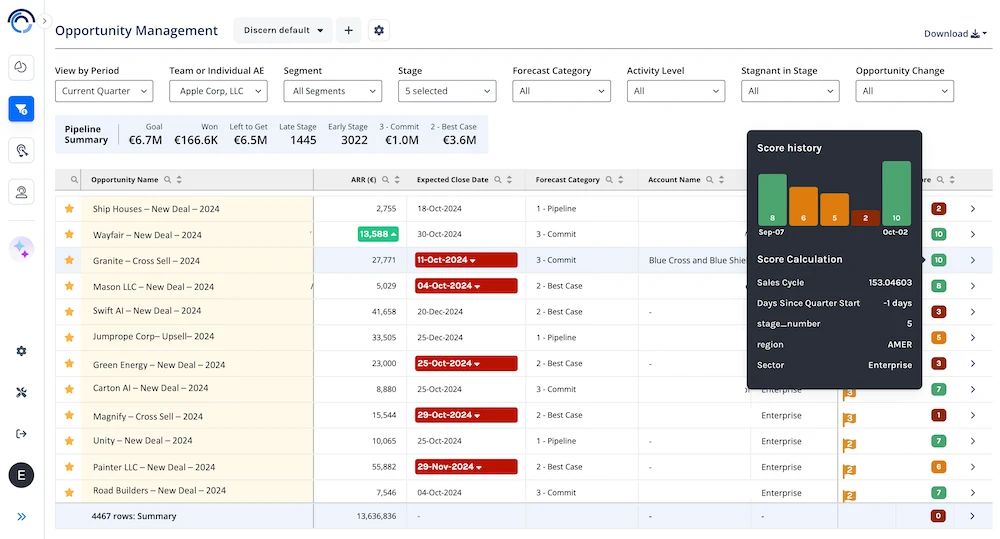Accurate Forecasting Trusted by Global Sales Teams
Reliable Predictions.
Better Planning.
Sales forecasting is a critical component of business planning, yet it remains an elusive target for many companies. In fact, a report by CSO Insights revealed that only 45% of sales organizations had win rates of 50% or greater on forecasted deals.
This sobering statistic underscores the widespread challenge of accurate sales forecasts, with many businesses struggling to achieve forecasts within even a 15% margin of error. The implications of this forecasting gap are significant, affecting everything from resource allocation to investor confidence.
Discern’s sales forecasting solution addresses this challenge by offering a unique dual approach that offers both quantitative forecasting and qualitative forecasting.
While AI-driven forecasts can sometimes miss critical qualitative information, and human predictions can be clouded by subjectivity, Discern’s sales forecasting software combines the best of both worlds, making it easier for revenue leaders to paint an accurate picture of future sales revenue and run data driven decision making.
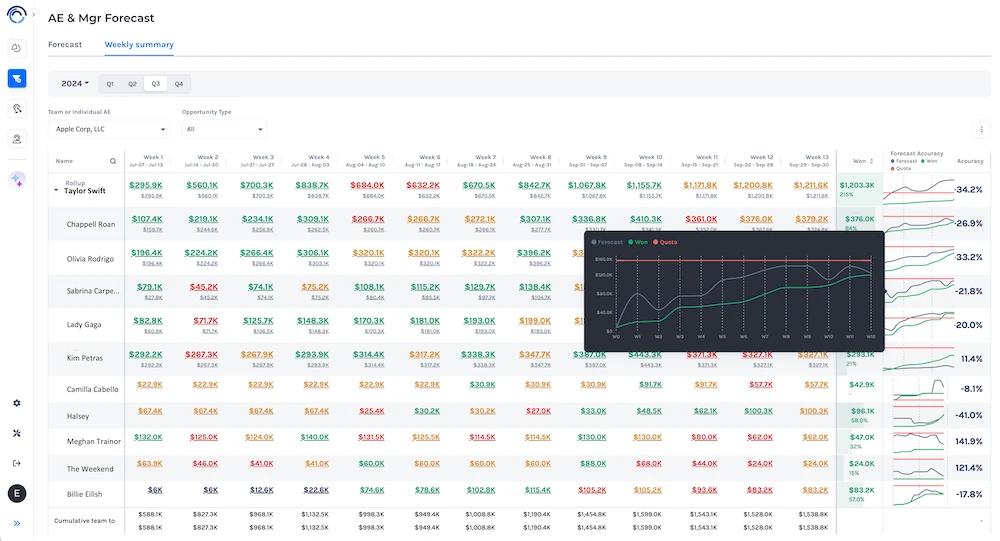
Improve Your Sales Performance With Better Process
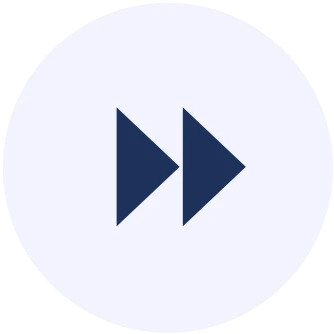
Plan With Confidence
Make data driven financial decisions with precise bookings forecasts. Align hiring and growth initiatives with a more accurate forecast.
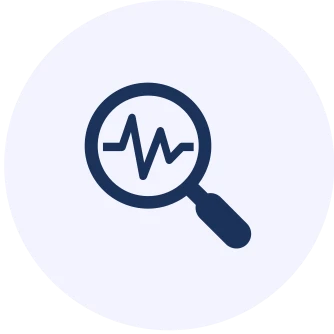
Improve CRM Hygiene
Make it easy for AEs to maintain critical CRM fields. Discern’s bi-directional CRM sync enables reps to update opportunity details directly from the platform as they forecast.
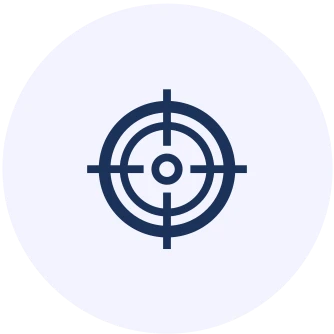
Remove the Rose Colored Glasses
Leverage AI-powered scoring to prioritize opportunities from an objective lens. Focus your efforts on high-potential deals and avoid wasting time on unlikely prospects.
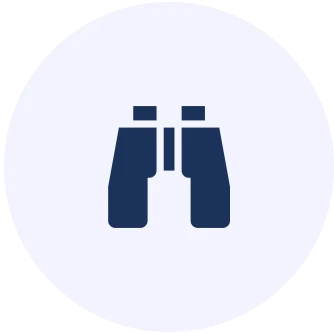
Improve Forecasting Accuracy Over Time
Track and improve forecasting accuracy at all levels. Coach reps and managers on enhancing prediction skills, leading to more reliable planning processes.
Case Study
The Challenge
Quantive faced significant challenges in achieving accurate sales forecasts due to cultural differences across its global offices. Different regional attitudes towards predicting close dates and opportunity amounts led to inconsistencies in sales forecasts across the business.
Discern’s Solution
With Discern, Quantive can now run accurate forecasting and improve their overall sales process.
Discern helps Quantive identify at-risk opportunities, and uncover key trends about which sales reps have poor CRM hygiene habits or forecast accuracy challenges.
AI Sales Forecasting Software Smart Enough to Knows What Matters For Your Business
We don’t just deliver a sales forecasting tool. As part of Discern’s sales forecasting solution, our Data Science teams works to create a custom logistic regression model for each Discern customer.
During your sales forecasting onboarding, our data science experts run dozens of models to identify the most accurate method for your unique business.
Our models take into account all available data including:
- Opportunity Qualifiers:
- Stage
- Forecast Category
- Industry
- Deal Size
- Opportunity Owner (AE)
- Last Activity
- Next Step
- Days in Stage
- # Pushes
- Etc.
- Existing Open Pipeline
- “Create and Close” Rates
- Seasonality
- AE-specific Habits
- Push Out Rates
- Pull in Rates
- Conversion Rates
- And More!
Discern FAQs
Discern’s sales forecasting software costs $500 quota carrying sales representative. It is important to note that Discern does not charge per user, meaning that business leaders can all use Discern and view the forecasts without adding additional cost to the business.
No, if you’d like to purchase our AI powered Sales Forecast tool, you will need to subscribe to our complete Sales Forecast app. This will provide you access to additional valuable insights in our bottoms up forecast workflow tool and our AI opportunity scoring.
By pricing all of this at $500 per AE, not per user, we think even if you just want to use our AI forecast, you’re getting a pretty good deal.
No, if you’d like to purchase our Bottoms-up forecast workflow tool for your AEs and Sales Managers, you’ll need to subscribe to our complete Sales Forecasting app. The full app provides you with objective, valuable insights into future revenue with our AI forecast and opportunity scoring.
By pricing all of this at $500 per AE, not per user, we think even if you just want to use our bottoms up forecast workflow, you’re getting a pretty good deal.
Implementing Discern’s sales forecasting software typically requires 1-3 days. During this period, Discern’s Data Scientists will ingest your CRM data and run dozens of logistic regression models to identify the most accurate model for your business.
Onboarding may take longer to train your sales team on the sales forecasting workflow and process. Our team is happy to provide training materials or run forecasting sessions to get everyone comfortable in the system.
Ready to run consistent forecasting with revenue predictability?
Contact our team to learn more about Discern’s data driven sales forecasting software.
Industry FAQs
A sales forecasting tool is used to predict future sales by analyzing various datasets, including historical performance, market trends, and open sales pipeline.
The primary function of these tools is to provide sales leaders and sales teams with predictive insights that help in setting realistic sales goals and preparing for future market scenarios. It also helps finance teams better plan resource allocation and expenses.
Many sales forecasting tools utilize algorithms and models to process large volumes of data, offering accurate forecasts that can significantly impact strategic decision-making and planning.
Other forecasting tools offer a bottoms up forecast workflow, that allows individual reps or managers to call certain deals and drive more consistent sales execution over time. Additionally, these tools can also help sales leaders manage the sales pipeline efficiently, improve forecast accuracy, and enhance overall sales performance.
The best sales forecasting software incorporates both data driven AI forecasting as well bottoms up forecasting.
Forecasting sales revenue is very important to planning. Without a good understanding of how many sales can come in in the coming months or quarters, finance teams will be unable to confidently put together a budget plan. If the business makes major investments on the assumption that sales targets will be met, there is great risk to the business if those targets are missed. Oftentimes, this leads to budget cuts or even layoffs.
As a result, it is critical for businesses to accurately forecast their sales revenue; and not just for the current quarter, but future quarters as well.
Creating a sales projection is a critical activity within the sales forecasting process, involving a detailed analysis of both quantitative and qualitative data to predict future sales. The process starts with the collection of sales data from the past, which provides a baseline for understanding past performance. Sales teams then analyze this data alongside current market trends to identify patterns and potential opportunities or challenges.
To enhance the accuracy of sales forecasting, companies often incorporate predictive analytics, leveraging sophisticated sales forecasting software that uses historical data to forecast future performance. This approach helps in identifying key performance indicators (KPIs) for sales performance and benchmarking them against industry standards. Sales managers and reps use these insights to set sales targets and quotas that are both ambitious and achievable.
Further, effective sales forecasting involves continuous monitoring and updating of projections to reflect real-time market changes and the sales team’s activities. This dynamic approach ensures that the sales projections remain relevant and actionable. Regular review meetings allow teams to adjust their strategies, refine their sales goals, and stay aligned with the overall business objectives. Thus, creating accurate sales projections is not just about predicting sales volumes but also about fostering a proactive, responsive, and strategically focused sales environment.
Running data driven sales projections or forecasts in Excel could involve a couple of methods.
A top down method in Excel would involve using older sales data and applying statistical techniques such as moving averages or linear regression.
A bottoms up method in Excel would involve listing out all active pipeline for the period selecting which opportunities to include in the forecast, and at which amount.
The downside of Excel compared to specialized forecasting software is the lack of sophistication in predictive analytics, as well as the lack of real time data syncs.
As such, for more advanced forecasting needs, most businesses turn to specialized sales forecasting tools. The best sales forecasting tools, like Discern, can provide companies with more accurate forecasts and the ability to integrate seamlessly with other business systems for comprehensive sales management.
Well, we sure think so! There are two approaches to forecasting that sales forecasting tools can offer:
The first is a top-down forecast. The forecast looks at all historical sales trends as well as your existing open pipeline to come up with accurate sales revenue projections for your business. The best sales forecasting tools that use AI in their top down forecast should get you between 96-99% accuracy in the first couple weeks of the quarter.
The second approach that forecasting tools offer is a bottoms-up forecast. This process enables reps or managers to look at each opportunity in the period and select which ones they commit to closing. These forecasts can usually get a company within 10% accuracy while also helping reps improve their sales process and CRM hygiene habits. It enables great coaching conversations between reps and their sales manager, too.
So, if you want to know does sales forecasting software work? We think the answer is absolutely yes!
Top-down and bottom-up are two fundamental approaches in sales forecasting, each serving distinct strategic needs.
Top-down forecasting begins with macro-level market or industry data and breaks it down to derive sales forecasts for specific segments or products. This approach is often driven by historical data and overarching sales strategies, making it useful for setting broad sales targets.
In contrast, bottom-up forecasting starts at the ground level, focusing on specific deals in the sales pipeline. This method aggregates these detailed insights to form a comprehensive forecast, providing a granular view that can often yield more accurate forecasts.
Bottom-up forecasting is particularly effective in environments where individual sales activities and specific transactions significantly influence overall performance. By leveraging detailed data from the sales process, companies using bottom-up forecasting can ensure more precise alignment with actual sales activities and market responsiveness.
Sales forecasting software can help both sales leaders and sales teams streamline the sales process, make data driven decisions, while improving overall forecast accuracy.
Machine learning in sales forecasting involves training algorithms on data from sales to predict future trends. These models analyze patterns in historical sales and open revenue pipeline. Machine learning enhances traditional forecasting by adapting to new sales data and trends, thereby improving accuracy.
This approach to sales forecasting is highly beneficial for complex datasets and dynamic markets where traditional forecasting methods may not suffice, offering a more nuanced understanding of sales drivers and potential future scenarios. It is particularly beneficial for companies with very high sales volumes and shorter sales cycles. The more data to feed the ML model, the better!
However, without sophisticated data science resources internally, it can be difficult (and expensive) to build a machine learning model without specialized forecasting software. We recommend looking at tools like Discern to unlock a specialized machine learning model custom for your business, at a low cost per sales rep!
Sales bookings and revenue forecasts are critical metrics for businesses but serve different purposes and are calculated differently. Bookings refer to the value of a contract signed with a customer for future sales and are recognized at the point of agreement before any service is delivered or payment is received. They reflect the sales commitments obtained by the sales team, indicating future cash flow and sales performance.
Revenue forecasts, on the other hand, are estimates of the actual money expected to be recognized as earned over a specific period. This forecasting accounts for factors like payment schedules, service delivery, customer churn, and other conditions affecting actual income.
They are crucial for financial planning as they provide insights into when booked sales will convert into recognized revenue, helping manage cash flow and assess the financial health of the company.
Sales projections are vital for several strategic and operational purposes within a company. They enable organizations to predict how many sales can close in a given period. A sales forecast can be used to plan business strategies, resource allocation, and budgeting processes. Accurate sales projections help in setting realistic targets, planning inventory, managing supply chains, and preparing for market fluctuations. They also guide the sales team in prioritizing efforts, setting quotas, and focusing on high-impact activities.
Additionally, sales forecasts are essential for stakeholder communication, providing investors and management with a clear view of the company’s growth potential and financial outlook. Efficient sales forecasting thus supports overall business planning, ensuring that the company remains competitive and well-positioned to capitalize on market opportunities.
Sales forecasting software like Discern can be used to automate or streamline future sales projections.
Choosing the right sales forecasting software for your business depends on your organization’s unique needs. If you have a large sales team, it is best practice to run sales forecasts out of forecasting software like Discern. However, if you have a small sales team, you can probably get away with running your forecast in your CRM or in Excel.
However, regardless of the size of your sales team, the benefits of running your sales forecasts in a forecasting tool like Discern includes:
- Sales forecast snapshot and trend analysis
- Sales forecasting accuracy scores by AE and team
- Bi-directional CRM sync for easy CRM field cleanup
- Automated sales reports for forecasting
The best forecasting tools should should tighten your sales process, provide real time insights and deliver forecasts that can be trusted by your CEO, finance team and investors.
